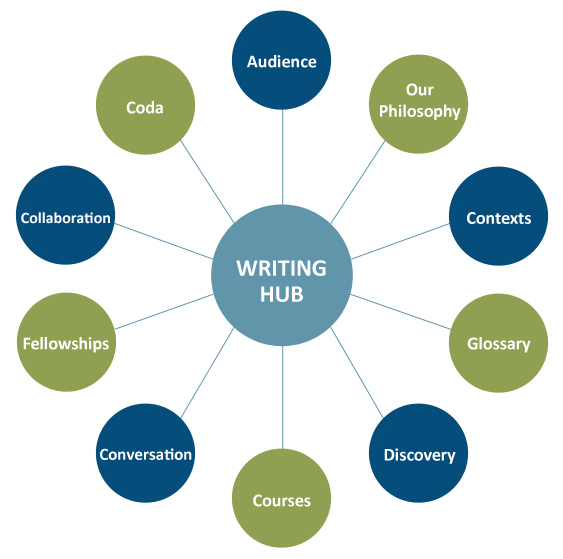GLOSSARY
By multimodalities, we are referring to Paul Prior et al’s (2007) definition: "how multiple modes operate together in a single rhetorical act and how extended chains of modal transformations may be linked in a rhetorical trajectory" (para. 2). And, if adopting Aristotle’s definition of rhetoric as "finding the available means of persuasion in a given situation," the multimodalities of the information age cannot be ignored, particularly social networking. Multimodality is central to the mission of the Writing Hub because it supports the notion of writing as epistemic (Bruffee, 1984; Burke, 1973) and highlights the multiple pathways to understanding, applying, and communicating information—thereby creating knowledge in the exchange among texts, interlocutors, and audiences. Kenneth Burke’s conversation metaphor is particularly powerful in demonstrating to students that no one has all the right answers all the time, and that at each stage of writing, we are engaging with a global, multimodal conversation that is ongoing, with people entering and exiting the conversation intermittently. Since our students come from all disciplines across the university, our aim is to instill not formulae, but habits of mind that support effective writing abilities—and ultimately a personal, individualized ethos for writing that builds students’ confidence in transferring their own writing abilities across disciplines, cultures, technologies, and countries.
By habits of mind, we are referring to the terminology used in the Framework for Success in Postsecondary Writing, a resource produced jointly by the Council of Writing Program Administrators, the National Council of Teachers of English, and the National Writing Project (2011)—three U.S.-based associations. The Framework identifies eight desirable habits of mind that lead to success in postsecondary writing: curiosity, openness, engagement, creativity, persistence, responsibility, flexibility, and metacognition.
The Writing Hub’s critical loop incorporates secondary school experiences, tertiary demands, and workplace expectations to address the transitional writing challenges students face and help them draw on the full range of their experiences to discover the most effective ways to communicate in real world scenarios. We have discovered that a smooth transition—into the university, within the university, and beyond into the professional world—hinges on students’ abilities to identify the appropriate communicative moves required in a range of different contexts and across a number of different texts. We believe a rhetorical approach to writing enables “seamless” transitions (to borrow from George Kuh’s 1996 work on “seamless learning”) between different tertiary and professional contexts by learning to communicate in a range of different modes. The Writing Hub’s aim, then, is to help students achieve multimodal fluency. Returning to Burke, a student’s multimodal fluency—developed through the practice of rhetoric—is the hub for all other communicative acts in university and professional life.

